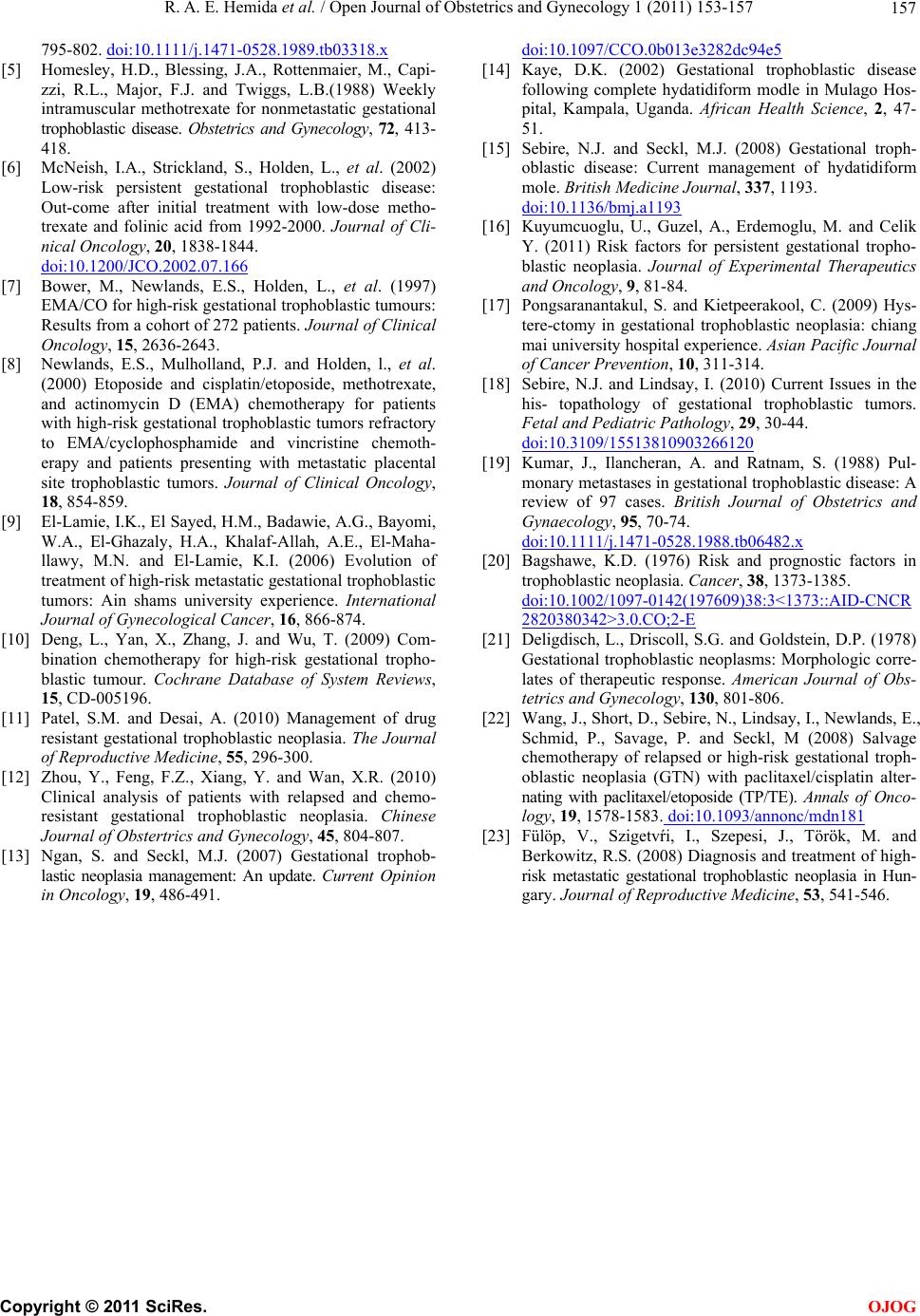
R. A. E. Hemida et al. / Open Journal of Obstetrics and Gynecology 1 (2011) 153-157
Copyright © 2011 SciRes.
157
OJOG
795-802. doi:10.1111/j.1471-0528.1989.tb03318.x
[5] Homesley, H.D., Blessing, J.A., Rottenmaier, M., Capi-
zzi, R.L., Major, F.J. and Twiggs, L.B.(1988) Weekly
intramuscular methotrexate for nonmetastatic gestational
trophoblastic disease. Obstetrics and Gynecology, 72, 413-
418.
[6] McNeish, I.A., Strickland, S., Holden, L., et al. (2002)
Low-risk persistent gestational trophoblastic disease:
Out-come after initial treatment with low-dose metho-
trexate and folinic acid from 1992-2000. Journal of Cli-
nical Oncology, 20, 1838-1844.
doi:10.1200/JCO.2002.07.166
[7] Bower, M., Newlands, E.S., Holden, L., et al. (1997)
EMA/CO for high-risk gestational trophoblastic tumours:
Results from a cohort of 272 patients. Journal of Clinical
Oncology, 15, 2636-2643.
[8] Newlands, E.S., Mulholland, P.J. and Holden, l., et al.
(2000) Etoposide and cisplatin/etoposide, methotrexate,
and actinomycin D (EMA) chemotherapy for patients
with high-risk gestational trophoblastic tumors refractory
to EMA/cyclophosphamide and vincristine chemoth-
erapy and patients presenting with metastatic placental
site trophoblastic tumors. Journal of Clinical Oncology,
18, 854-859.
[9] El-Lamie, I.K., El Sayed, H.M., Badawie, A.G., Bayomi,
W.A., El-Ghazaly, H.A., Khalaf-Allah, A.E., El-Maha-
llawy, M.N. and El-Lamie, K.I. (2006) Evolution of
treatment of high-risk metastatic gestational trophoblastic
tumors: Ain shams university experience. International
Journal of Gynecological Cancer, 16, 866-874.
[10] Deng, L., Yan, X., Zhang, J. and Wu, T. (2009) Com-
bination chemotherapy for high-risk gestational tropho-
blastic tumour. Cochrane Database of System Reviews,
15, CD-005196.
[11] Patel, S.M. and Desai, A. (2010) Management of drug
resistant gestational trophoblastic neoplasia. The Journal
of Reproductive Medicine, 55, 296-300.
[12] Zhou, Y., Feng, F.Z., Xiang, Y. and Wan, X.R. (2010)
Clinical analysis of patients with relapsed and chemo-
resistant gestational trophoblastic neoplasia. Chinese
Journal of Obstertrics and Gynecology, 45, 804-807.
[13] Ngan, S. and Seckl, M.J. (2007) Gestational trophob-
lastic neoplasia management: An update. Current Opinion
in Oncology, 19, 486-491.
doi:10.1097/CCO.0b013e3282dc94e5
[14] Kaye, D.K. (2002) Gestational trophoblastic disease
following complete hydatidiform modle in Mulago Hos-
pital, Kampala, Uganda. African Health Science, 2, 47-
51.
[15] Sebire, N.J. and Seckl, M.J. (2008) Gestational troph-
oblastic disease: Current management of hydatidiform
mole. British Medicine Journal, 337, 1193.
doi:10.1136/bmj.a1193
[16] Kuyumcuoglu, U., Guzel, A., Erdemoglu, M. and Celik
Y. (2011) Risk factors for persistent gestational tropho-
blastic neoplasia. Journal of Experimental Therapeutics
and Oncology, 9, 81-84.
[17] Pongsaranantakul, S. and Kietpeerakool, C. (2009) Hys-
tere-ctomy in gestational trophoblastic neoplasia: chiang
mai university hospital experience. Asian Pacific Journal
of Cancer Prevention, 10, 311-314.
[18] Sebire, N.J. and Lindsay, I. (2010) Current Issues in the
his- topathology of gestational trophoblastic tumors.
Fetal and Pediatric Pathology, 29, 30-44.
doi:10.3109/15513810903266120
[19] Kumar, J., Ilancheran, A. and Ratnam, S. (1988) Pul-
monary metastases in gestational trophoblastic disease: A
review of 97 cases. British Journal of Obstetrics and
Gynaecology, 95, 70-74.
doi:10.1111/j.1471-0528.1988.tb06482.x
[20] Bagshawe, K.D. (1976) Risk and prognostic factors in
trophoblastic neoplasia. Cancer, 38, 1373-1385.
doi:10.1002/1097-0142(197609)38:3<1373::AID-CNCR
2820380342>3.0.CO;2-E
[21] Deligdisch, L., Driscoll, S.G. and Goldstein, D.P. (1978)
Gestational trophoblastic neoplasms: Morphologic corre-
lates of therapeutic response. American Journal of Obs-
tetrics and Gynecology, 130, 801-806.
[22] Wang, J., Short, D., Sebire, N., Lindsay, I., Newlands, E.,
Schmid, P., Savage, P. and Seckl, M (2008) Salvage
chemotherapy of relapsed or high-risk gestational troph-
oblastic neoplasia (GTN) with paclitaxel/cisplatin alter-
nating with paclitaxel/etoposide (TP/TE). Annals of Onco-
logy, 19, 1578-1583. doi:10.1093/annonc/mdn181
[23] Fülöp, V., Szigetvŕi, I., Szepesi, J., Török, M. and
Berkowitz, R.S. (2008) Diagnosis and treatment of high-
risk metastatic gestational trophoblastic neoplasia in Hun-
gary. Journal of Reproductive Medicine, 53, 541-546.